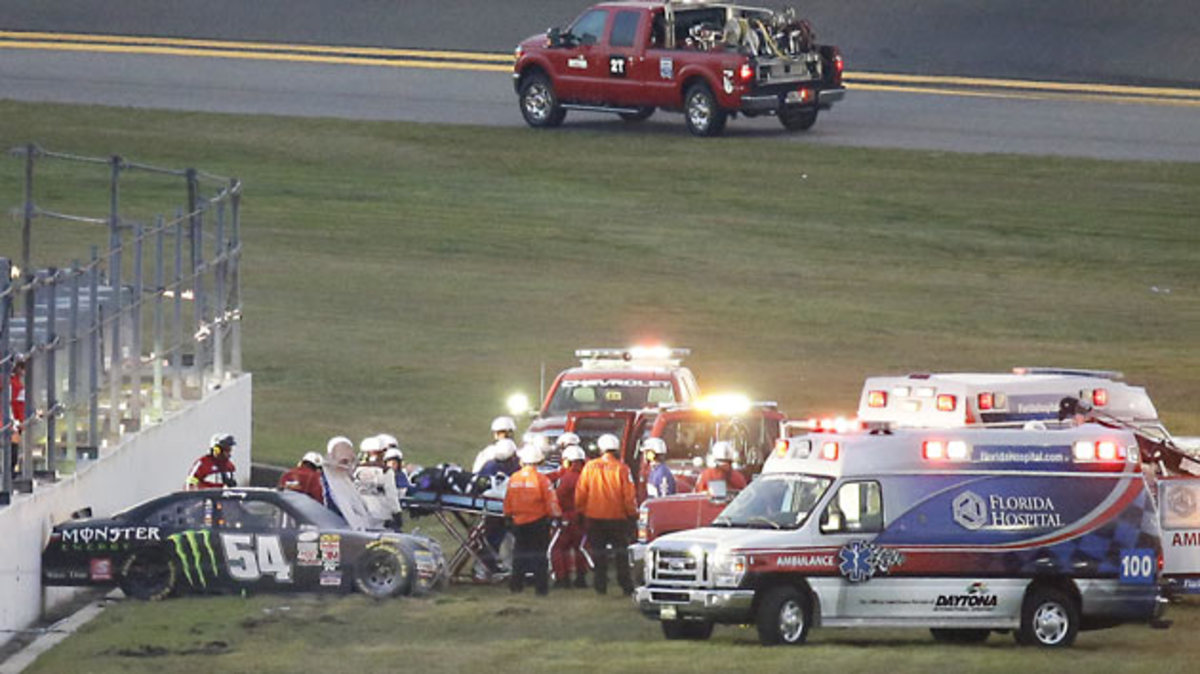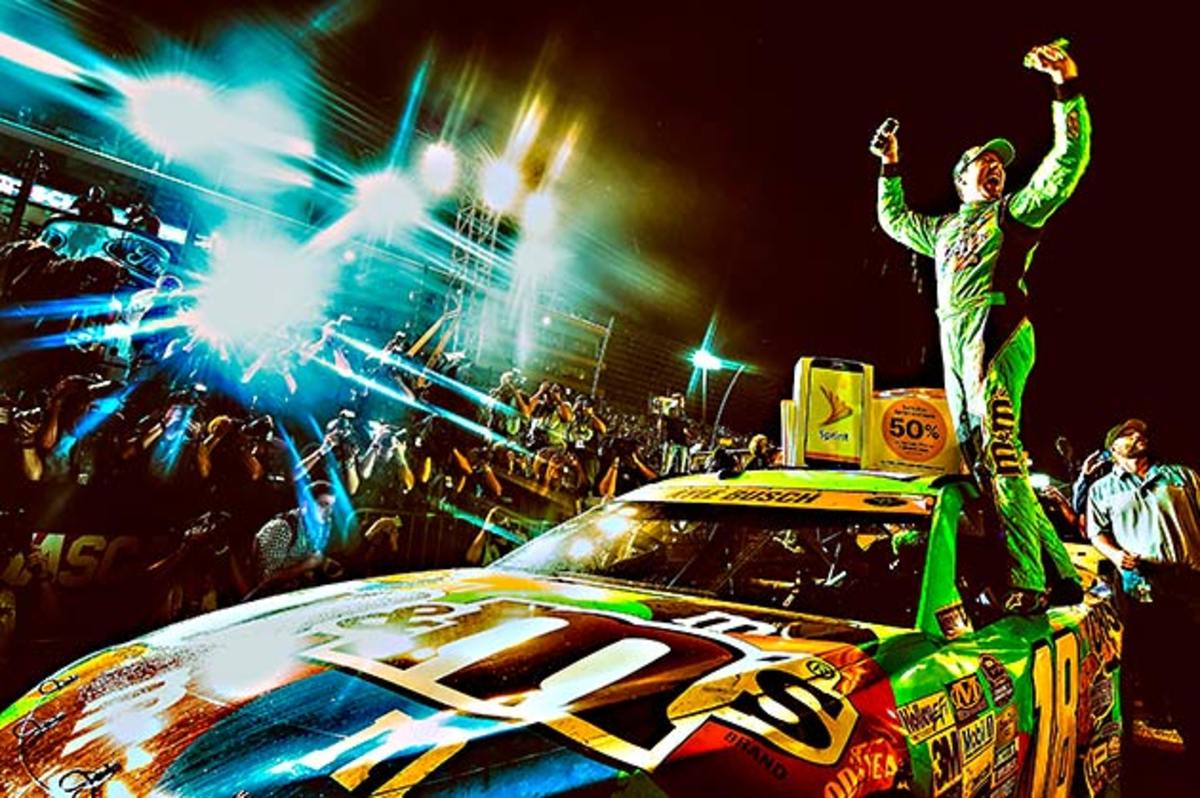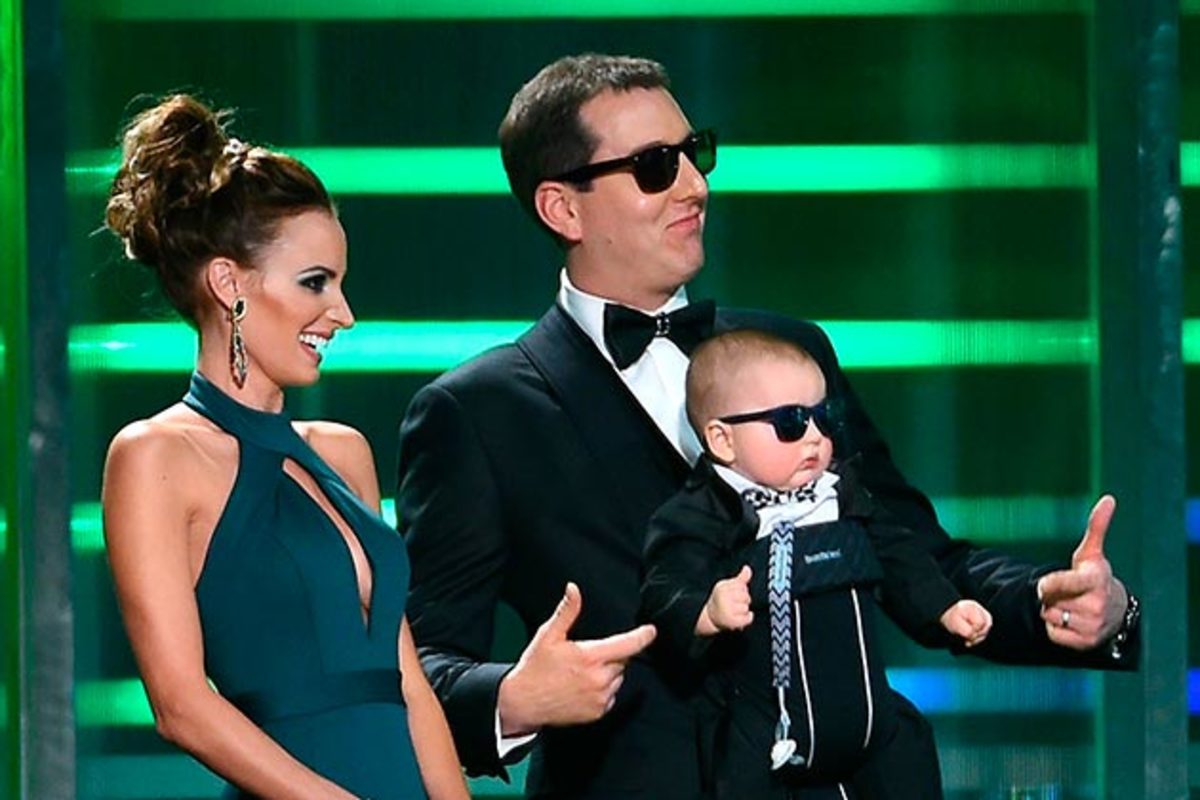Burning desire: Kyle Busch stamps himself as one of racing's best

This story appeared in the Feb. 15, 2016 issue of SPORTS ILLUSTRATED. To subscribe, click here.
For the past 16 years Maryann Kuchar has operated a one-woman, appointment-only tailoring business out of her Daytona Beach, Fla., condo called Sew What? Inevitably during the month of February, when NASCAR descends on Kuchar’s hometown for the opening events of its nine-month traveling circus, she’ll get a call from a racer or crewman who needs a sponsor patch added or removed from a firesuit or uniform. Last year, though, almost three weeks passed without a single inquiry.
But then at 8 a.m. on the final Sunday of that stretch, five hours before the start of the Daytona 500, her phone rang. It was Adam Stevens, a Sprint Cup crew chief from Joe Gibbs Racing. His driver, Kyle Busch, a perennial Cup Series title contender and a favorite in the 500, was in the hospital after crashing nosefirst into a concrete barrier during the previous night’s Xfinity race at the Speedway. Busch’s emergency replacement, Truck Series driver Matt Crafton, had tried slipping into Busch’s neon-green firesuit—the only one available that matched Busch’s M&M’s Toyota—but the pants legs were three inches too long. Ty Gollott, Busch’s motorcoach driver, had the livery and was en route to Kuchar’s condo from the Speedway, four miles away. Could she hook up a quick hem?
“No problem,” Kuchar said.
Also, Stevens wondered, “you have fire-retardant thread, right?” No, Kuchar said, but she did have some high-quality cotton string that could do the trick. (“Nylon or polyester threads, they melt,” she explains, “but cotton, that just burns up.”) After 45 minutes of fighting race-day traffic, Gollott arrived at the condo with the suit, and Kuchar turned the job around in less than 10 minutes. For compensation, the seamstress—a huge Busch fan—had planned on just taking the trimmed firesuit cuffs from her sewing table. (“I felt like it was a privilege to do this for Kyle,” she says.) But when Gollott insisted on being billed, Kuchar scratched out an invoice for $19.70. After realizing she was a Busch supporter, Gollott volunteered an update on the driver’s condition: bone fractures in his right leg and left foot and a sprained left finger. The diagnosis was grim, but not hopeless. “I know,” she said, “broken bones are not going to keep him down.”
• Complete 2016 NASCAR Sprint Cup Season Preview

Across NASCAR Nation there are many folks who look at Busch’s improbable march from that Saturday night wreck in February to the 2015 Sprint Cup championship in November and believe an injustice was done. They point to the 11 starts he missed while recovering from his injuries. They scoff at the medical exemption Busch received to remain in the title hunt, which required only that he win once and finish the 36-race regular season among the top 30 in points. They slam NASCAR’s stick-and-ball “playoff” format, the 10-race Chase—which, unfortunately for these haters, is expanding to the Truck and Xfinity series this season.
Infographic: Previewing Daytona 500
It’s a perspective that overlooks so much: the single-mindedness Busch needed to rehab from two busted appendages; the grinding pain he suffered while racing with orthopedic hardware; the slim chances he faced of winning even a single Cup race with only 15 remaining in the regular season. What Busch did—take five checkered flags, including one (at Kentucky) that was run using a lower downforce package that will be the standard in 2016—was extraordinary. On the list of greatest comebacks in motor sports history it is a lock for second, behind only Niki Lauda’s return from a fiery, near-fatal crash to within a point of the 1976 Formula 1 championship.
Just as impressive as Busch’s epic run, has been his attitude upshift. The notoriously temperamental driver had spent a decade frantically chasing a Cup title amid the highest of expectations. But since fulfilling his quest—in large part thanks to his own shockingly deep resolve and his rookie crew chief’s talent for tackling every logistical issue (down to the last-minute alteration of a firesuit)—the 30-year-old Busch has emerged as that most dangerous kind of title contender: one immune to pressure. “I feel like a huge weight has been lifted off my shoulders,” he says, “and that may allow me to be a better race car driver yet.”
Even before the breakthrough Busch was more than just a superb driver. He was a hustler, collecting trophies in the Truck and Xfinity series while he ran in Cup, ever intent on attaining a personal goal of 200 victories—he needs 46 more—across NASCAR’s three national touring series. He was relentless, flogging the pedals so hard that he had needed two surgeries on his right foot to remove broken bone fragments. Often his ride was even the worse for wear. The running joke at the Gibbs shop is that anyone can tell how well Busch has raced by checking the right side of the car. Creases and abrasions and missing chunks, which occur when Busch swipes the wall, indicate a strong performance.
But earlier in his career, like a lot of young and gifted drivers, Busch was also terribly insecure. (Seeing his older brother, Kurt, win a Cup title in 2004, the first year of the Chase, at age 25 didn’t help.) Busch fretted constantly over his professional status, even though it hasn’t really been threatened since ’07, when he left Hendrick Motorsports (the supershop where he began as an 18-year-old) for the Gibbs franchise. He still kicks himself for not bringing home the Cup title that first season at Gibbs, when he won a career-high eight races (but none in the Chase). In those early years team owner Joe Gibbs can recall more than a few perfectly benign conversations with Busch that ended with the driver blurting out, “I could lose my job!”
• Subscribe to get the best of Sports Illustrated delivered right to your inbox
“I’m going, ‘Listen to yourself. . . .’ ” says Gibbs. For plenty of trackside fans, Busch’s outbursts alone justified the price of a scanner radio. “Generally, if he’s thinking something,” Gibbs continues, “you’re gonna get it.”
Add to that sharp tongue a healthy taste for confrontation, and you have a racer headed for trouble fast. Right when prevailing sentiments about Busch were tilting toward respect, he put a race leader (Dale Earnhardt Jr.) into the wall in the late stages of a 2008 Cup race at Richmond, and likewise sabotaged a championship contender (Ron Hornaday Jr.) during an ’11 Truck race in Texas, an infraction that earned Busch a suspension from the rest of that weekend’s events. From then on, Busch became the driver fans most love to hate. He figured to get an earful again last year, during the introductions at Daytona. But when it came time to bring him out, another driver was in his candy-bedecked firesuit.

Busch is no fan of restrictor plate racing, which takes place on superspeedways. His particular talent is car control, and plate racing—more of an exercise in slipstreaming—doesn’t quite allow for that. “Years ago I did enjoy it because I was actually kind of successful,” says Busch, a seven-time superspeedway winner. “But the other 90%—of not winning—I’ve been crashed.”
Yet in the 2015 Xfinity race at Daytona, he had dodged a Big One and was running near the front with nine laps to go. As he positioned his car to push Gibbs teammate Erik Jones ahead of him, Busch’s car stalled in the turbulent air and triggered an eight-car wreck that sent him veering into a concrete barrier on the infield. “As soon as the impact happened, I instantly knew the right leg was broken,” says Busch. “I could feel my toes, but when I would lift my leg, the rest of it would stay down.”
As flames licked the front of his car, Busch tried boosting himself out of the cockpit, but when he pushed off his left foot for leverage, he knew something wasn’t right there, either. Ultimately he got as far as the window, where he was met by first responders, put on a stretcher and rushed to the infield care center. “I flipped my visor open to talk to the safety worker, to say basically, ‘Hey, right leg’s broke, left foot’s broke.’ I must’ve said it five times over because I figured: a) he can’t hear me, or b) he’s not gonna believe me.”
Stevens, a 37-year-old Gibbs veteran who had recently been promoted to oversee Busch’s Cup program, watched this scene unfold while eating dinner at his hotel. Immediately he sped with car chief Nate Bellows to Halifax Health Medical Center ahead of Busch’s arrival. “You’ve got a lot of emotions at that point because one, your friend’s hurt; and, two, the Daytona 500’s tomorrow, we’re expected to be in it, and we don’t know who’s going to drive the car. And then once we got the list figured out of who’s even a potential candidate, they have to be approved by NASCAR, they have to fit in your car. There’s a lot of little silly things that had to be done.”
While Stevens huddled with the rest of the Gibbs brass at the hospital, Busch’s wife, Samantha, was trying to keep her composure. After all, she and Kyle had a deal. “If he were ever to get in a wreck,” she explains, “he has to come over the radio and just let us all know he’s O.K.” But that call never came. Samantha didn’t get an immediate update at the hospital either. The anxiety was unbearable, not least because she was 28 weeks pregnant with their first child. “After about 30 minutes I lost my cool: I got the water works and the pregnant belly going and told them, ‘I really need to get back there.’ ”
Finally past the front desk, she found her husband in a haze of pain medication and adrenaline, ordering doctors to “bring her back here. Once she sees me, we’ll all be fine.” Still, the sight of his exposed right leg bone, under the fluorescent lights, appeared to throw her slightly. Busch, though, thinks maybe she had simply felt the baby kick. (That wasn’t it.) Then he hit her with this: “I don’t think I’m gonna be able to race tomorrow.”
As his firesuit was being altered, Busch was waking up from the previous night’s surgery with a deep pain in his right knee. Doctors had drilled through the top of the joint and then hammered a 20-inch rod straight through his muscles and tendons all the way down to his ankle. (“I was like, You screwed up a perfectly good knee!” Busch says.) Two days later—after a respectable 18th-place finish by Crafton—Busch flew by private charter to Charlotte and on the following day underwent another procedure on his left foot.
After those operations Busch’s spirits hit their nadir. He went from thinking his racing career was over (and mulling a return to his old high school job, laying decals) to believing he could come back but never be the same hard-charging driver. The task of rehabbing both legs at once was equally daunting to Busch. Samantha acted as nurse, transforming the living room of their Denver, N.C., house into a hospital room; she helped him take showers—a process that between sealing his cast-encased legs in trash bags and wheeling him in and out of the stall, could take as long as two hours.
And then on the 10th day, Busch stood up for the first time since his surgeries. Before long he was rolling through Gibbs HQ in a wheelchair and sitting in on competition meetings. His time away from the track created the opportunity for perspective. His team got an undistorted gauge for the speed of their cars as a Cup veteran (David Ragan) and a newbie (Jones) traded turns at the wheel in the season’s next 10 races. Busch got to feel what it’s like not to have at least one race to look forward to each weekend. He missed it desperately.
By late March, Busch was shuffling around with the aid of a walker. The following month he was in a walking boot. On May 12 he announced he would be making his return in four days, at the Charlotte All-Star race—which, it would turn out, was two days before he and Samantha welcomed a baby boy named Brexton. The next day NASCAR, after intense lobbying from the Gibbs team, granted Busch a Chase exemption. While JGR believed that Busch could bag at least one victory by season’s end, the team thought a top 30 finish was too tall an order. His average finish would have to hover around the mid-teens. “We’re more than capable of running better than that,” says Stevens. “But the average finish is going to average all your bad days too, when you blew a tire or a motor or made a bad pit call.”
And then, of course, this is Kyle Busch we’re talking about.

The man has been known to melt down when things don’t go his way. And though he was back at the track, he was hardly back to normal. His knees and ankles locked up during races. It hurt to stand afterward. He needed a golf cart just to reach the main stage for driver introductions (where, as it turns out, he was met with cheers).
Busch gritted his way through it all. Right after running in the All-Star race, in which he placed sixth, he made his first points race start of the year in the Coca-Cola 600, the longest race of the NASCAR season, and finished 11th. But in two of his next three starts, at Dover and Michigan, he crashed out late after running in the top five. It was the one stretch during his recovery when he could really feel himself pressing. “That’s when I told myself, ‘Look, you’re overdriving yourself, the car, the equipment—everything—trying to make up all these points,’ ” Busch says. With 11 weeks left in the season, he decided to be patient.
What happened next beggars belief. He won four of the next five races, starting with Sonoma—a road course event that necessitates vastly more footwork to operate the clutch and brake pedals. The next three stops—at Kentucky, Loudon and Indianapolis—were all run under different rules packages, adding to the demands on every driver. By the time Busch rolled out of Watkins Glen (the other road course race on the Cup schedule) on Aug. 9, he ranked 30th in points. By the final race, at Richmond, he was a robust 27th.
When the Chase commenced, he took it nice and slow, points racing his way through the first two rounds before earning top fives in his next three starts to make it into the final four for the finale, at Homestead-Miami Speedway. Pitted against four-time Cup champion Jeff Gordon, making the last start of his glorious 24-year career, defending champ Kevin Harvick and the upstart Martin Truex Jr., Busch once again refused to rush. He sat back inside the quick car his team turned around for him and focused only on staying ahead of his championship rivals.
When Busch surged all the way to second, behind noncontender Brad Keselowski, down the stretch, Stevens came over the radio and told him to abandon pursuit. “And I’m thinking to myself, ‘Yeah. I know,’ ” Busch recalls. “But then I realized I was catching [Keselowski] because he was slowing down to me. I was just running a normal pace.”
Then with 10 laps to go, the caution flag came out for debris, narrowing all the gaps in traffic. “In the old days,” says Gibbs, “Kyle would’ve gone ballistic at that. But he never said a word.” He just regrouped for a restart on the front line against Keselowski and then mashed the gas. Eight laps later he was a winner twice over. That he could celebrate with his family made the moment so much sweeter.
Since capping off that improbable comeback last November, the new champion has had even more reason to rejoice. In mid-December, Busch had all that hardware removed from his legs. His second bout with rehab has gone so smoothly that he expects to be fully back to his old self by Daytona. Or, rather more to the point, back to full strength as his new self, at which time he’ll keep ticking off the victories until he gets to 200. With a Zen approach he could have that goal all sewn up in no time.
